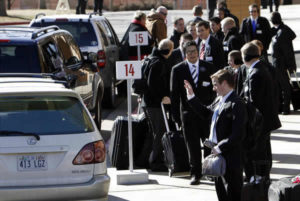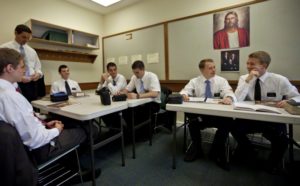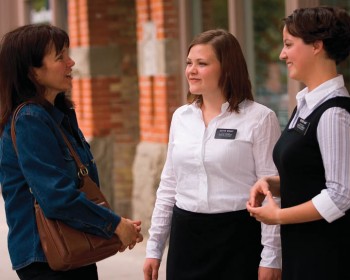 Each week hundreds of families around the world take their sons and daughters to Missionary Training Centers (MTCs) and bid them farewell for 18 to 24 months. The MTC is where their sons and daughters embark on the beginning of their journey as a full-time missionary for The Church of Jesus Christ of Latter-day Saints. Once they enter the MTC, they are expected to devote all of their time and attention to preparing to teach others about Jesus Christ. Some will remain at the MTC for as short a period as two weeks, whereas those who are learning a foreign language will remain at the MTC for nine weeks, before departing to their assigned mission.
Each week hundreds of families around the world take their sons and daughters to Missionary Training Centers (MTCs) and bid them farewell for 18 to 24 months. The MTC is where their sons and daughters embark on the beginning of their journey as a full-time missionary for The Church of Jesus Christ of Latter-day Saints. Once they enter the MTC, they are expected to devote all of their time and attention to preparing to teach others about Jesus Christ. Some will remain at the MTC for as short a period as two weeks, whereas those who are learning a foreign language will remain at the MTC for nine weeks, before departing to their assigned mission.
Approximately one in four Americans speaks a foreign language. However, because Mormon missionaries serve in many different parts of the world, the percentage of Mormons who are fluent in other languages is higher than average. Not only are they fluent in other languages, but they are taught languages at a more accelerated pace. For example, a Mormon missionary assigned to a mission where he or she will speak Mandarin Chinese spends a total of nine weeks studying and learning the language at the MTC, whereas the U.S. military has an intense 64-week course in Mandarin taught at the Defense Language Institute in Monterey, California.
 How does the Church teach foreign languages with great effectiveness in short periods of time? A June 2014 National Public Radio (NPR) report shares this insight: “They accomplish it through intense classroom instruction from teachers who are former missionaries, daily practice in realistic teaching situations, and learning by and following the Holy Spirit. As one missionary tells NPR, “Everything we do is trying to learn by and with the Spirit.””
How does the Church teach foreign languages with great effectiveness in short periods of time? A June 2014 National Public Radio (NPR) report shares this insight: “They accomplish it through intense classroom instruction from teachers who are former missionaries, daily practice in realistic teaching situations, and learning by and following the Holy Spirit. As one missionary tells NPR, “Everything we do is trying to learn by and with the Spirit.””
The MTC in Provo, Utah teaches 56 languages. Thirty-one of those languages require a maximum of nine weeks of study and training. Twenty-six of those thirty-one languages are Asian or Eastern Bloc languages. The Church also has 14 international MTCs that teach seven foreign languages. International MTCs also provide native language training in 17 languages for missionaries not learning a second language. Each instructor is either a native speaker or is fluent in the language because of his or her missionary service.
To learn the language that they will be speaking to teach the gospel, missionaries study the language for 6 to 8 hours a day. After a few weeks of study, they are asked only to communicate in the language they are studying. They are also encouraged to pray, read the scriptures, and even think in the language they are learning.
Speaking of the challenges that missionaries face in learning a foreign language, President Thomas S. Monson has commented that he “marvels at the devotion and total concentration of these young men and women as they grapple with the unfamiliar and learn the difficult.” In a 2013 interview with The Salt Lake Tribune, Col. Derek Tolman, commander of Utah National Guard’s linguistic unit, remarked that MTCs are “excellent at teaching the fundamentals in a short time. The students are highly motivated, and the learning curve is amazing.”
In addition to language instruction, teachers also provide cultural training to help missionaries make a smoother transition into their assigned foreign country.
About Keith L. Brown
Keith L. Brown is a convert to The Church of Jesus Christ of Latter-day Saints, having been born and raised Baptist. He was studying to be a Baptist minister at the time of his conversion to the LDS faith. He was baptized on 10 March 1998 in Reykjavik, Iceland while serving on active duty in the United States Navy in Keflavic, Iceland. He currently serves as the First Assistant to the High Priest Group for the Annapolis, Maryland Ward. He is a 30-year honorably retired United States Navy Veteran.



